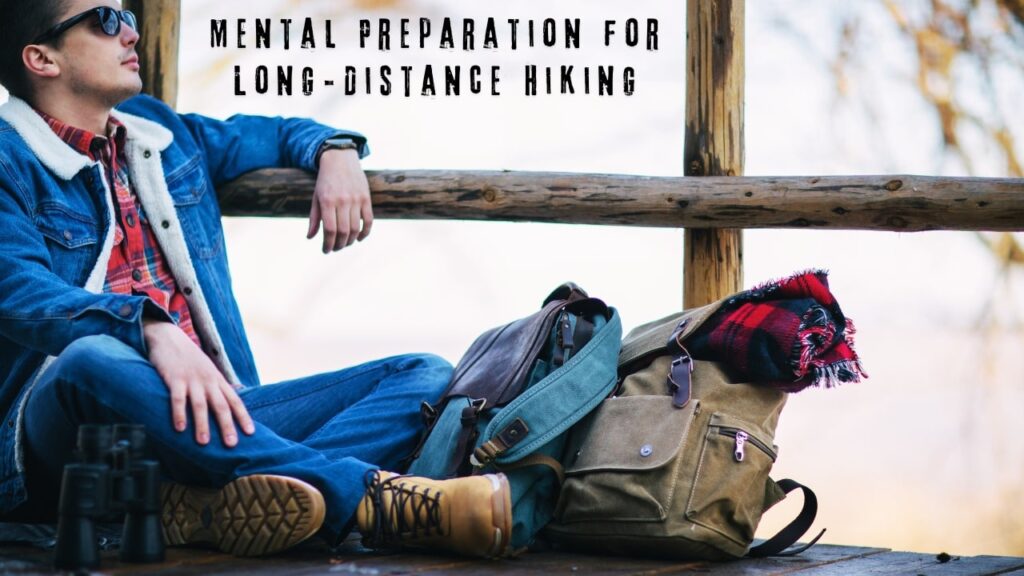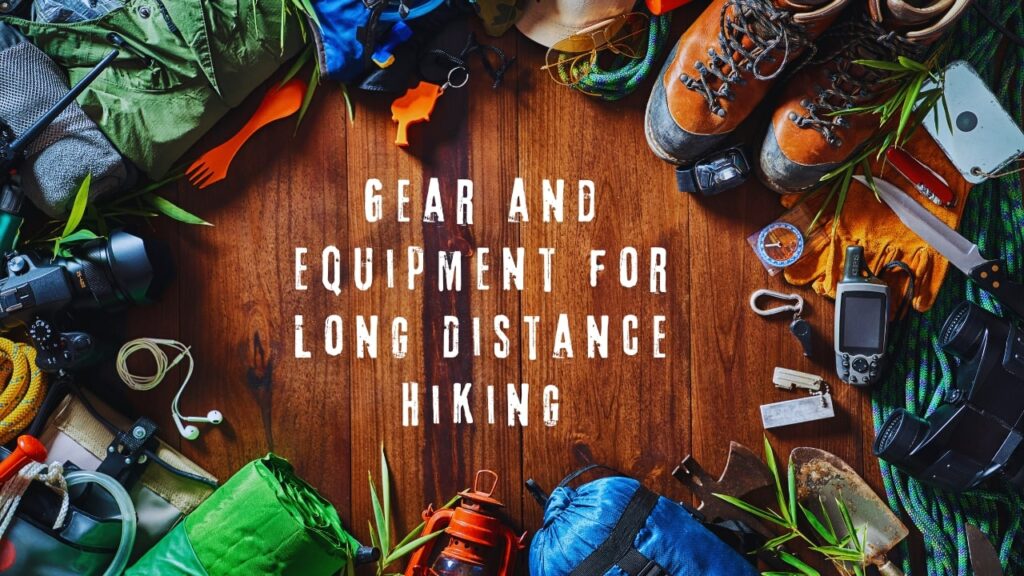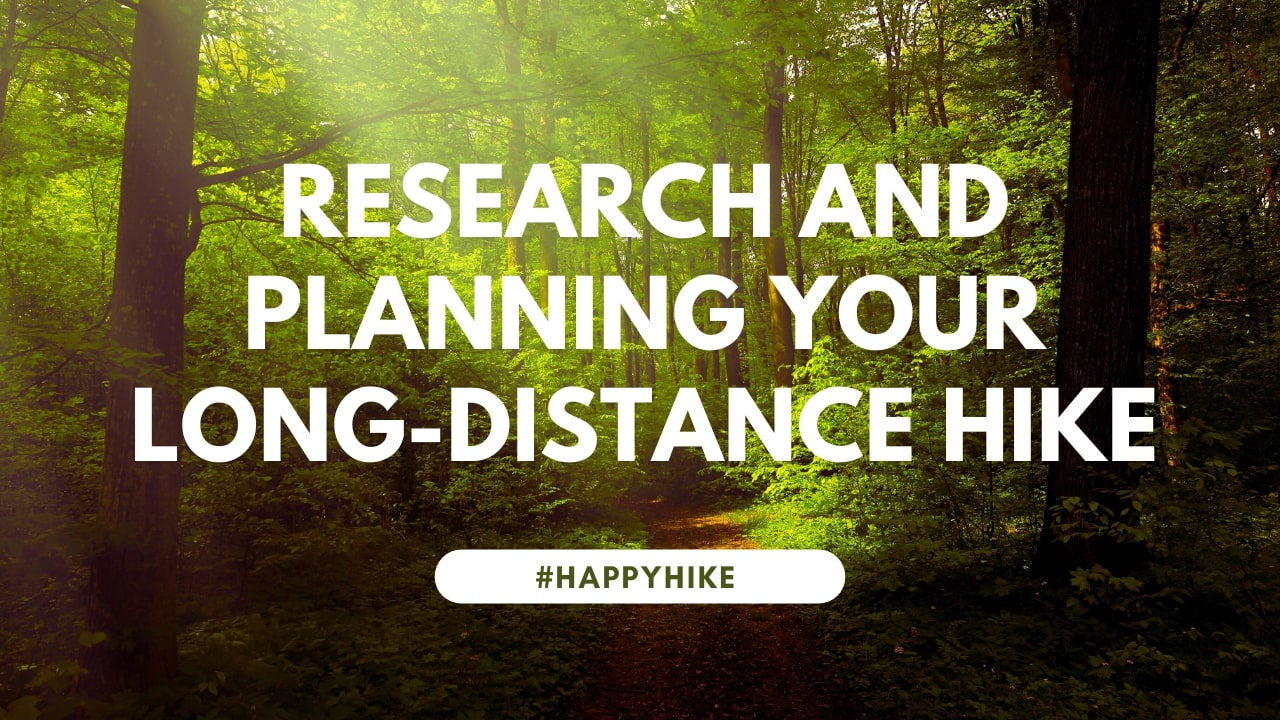Introduction
Long-distance hiking is an adventurous and rewarding activity that offers an escape into nature and a chance to test your physical and mental limits. Whether planning to hike a famous trail like the Appalachian Trail or the Pacific Crest Trail or exploring lesser-known paths, proper preparation is crucial for a successful and enjoyable experience. This Guide will explore how to prepare for long-distance hiking, covering essential aspects such as physical and mental preparation, gear selection, nutrition, and safety tips. By following these guidelines, you can ensure you are well-prepared for the challenges and joys of long-distance hiking.
Research and Planning Your Long-Distance Hike
Proper research and planning are the cornerstones of a successful long-distance hike. Here are the key steps to ensure you are well-prepared:
Choosing the Right Trail
It is crucial to select the right trail for your long-distance hike. Consider factors such as your fitness level, experience, and the type of scenery you prefer. Some popular long-distance trails include the Appalachian Trail, the Pacific Crest Trail, and the Continental Divide Trail. Research each trail’s difficulty, length, and accessibility to determine which suits you best.
Understanding Trail Conditions and Weather Patterns
Before embarking on your hike, it’s essential to understand the trail conditions and weather patterns. Check the trail’s official website or visit forums where hikers share their experiences. Pay attention to seasonal weather changes, trail closures, and other hazards. Websites like AllTrails and Hiking Project provide valuable information and user reviews.
Setting Realistic Goals and Timelines
Setting realistic goals and timelines helps you stay motivated and on track. Determine how many miles you plan to hike daily, considering factors like elevation gain and terrain difficulty. Create a detailed itinerary, but remain flexible to accommodate unforeseen circumstances. Use tools like the Hiking Calculator to estimate your hiking speed and plan your schedule.
Physical Preparation for Long-Distance Hiking
Preparing your body for the physical demands of long-distance hiking is essential. Building stamina, strength, and flexibility will ensure you can handle long days on the trail without injury or excessive fatigue. Here’s how to get started:
Building Stamina and Endurance
Long-distance hiking requires excellent cardiovascular endurance. Start by incorporating aerobic exercises into your routine, such as:
- Running or jogging: Aim for at least 30 minutes, 3-4 times a week.
- Cycling: A low-impact option that also builds leg strength.
- Swimming: A full-body workout that’s easy on the joints.
- Hiking shorter trails: Gradually increase your distance and pack weight to simulate trail conditions.
Strength Training Exercises
Strength training is vital for supporting your joints and carrying a heavy backpack. Focus on exercises that target key muscle groups:
- Legs: Squats, lunges, and step-ups improve leg strength and stability.
- Core: Planks, Russian twists, and leg raises enhance balance and reduce the risk of back pain.
- Upper body: Push-ups, pull-ups, and shoulder presses build the strength to carry your pack.
Incorporate strength training into your routine at least twice a week.
Flexibility and Balance Training
Flexibility and balance are crucial for navigating uneven terrain and avoiding injuries. Incorporate activities such as:
- Yoga: Enhances flexibility and mental focus.
- Dynamic stretching: Prepares your muscles for activity and reduces the risk of strains.
- Balance exercises: Single-leg stands and stability ball exercises improve proprioception and prevent falls.
Sample Training Schedule
To help you get started, here’s a sample 8-week training schedule:
- Weeks 1-2: Build a base with light aerobic exercises (walking, jogging) and basic strength training.
- Weeks 3-4: Increase the intensity and duration of your workouts. Incorporate longer hikes with a light backpack.
- Weeks 5-6: Add more weight to your pack and include elevation changes in your hikes. Continue strength and flexibility training.
- Weeks 7-8: Focus on simulating trail conditions as closely as possible. Hike with a fully loaded pack and aim for longer distances.
Mental Preparation for Long-Distance Hiking

Preparing mentally for long-distance hiking is just as important as physical preparation. Mental resilience, motivation, and coping with solitude and challenges can make or break your hiking experience. Here’s how to gear up mentally:
Staying Motivated
Long-distance hiking is a test of endurance and persistence. Staying motivated throughout the journey is crucial:
- Set Personal Goals: Establish clear, achievable goals for your hike. Whether reaching a particular milestone or enjoying the scenery, having goals can keep you focused.
- Visualize Success: Spend time visualizing yourself completing the hike. This mental practice can boost your confidence and determination.
- Read Inspiring Stories: Look up stories of successful long-distance hikers, like those on The Trek, to draw inspiration from their experiences.
Developing Mental Resilience
Building mental resilience helps you cope with the inevitable challenges you’ll face on the trail:
- Practice Mindfulness: Engage in mindfulness meditation or breathing exercises to enhance mental clarity and calmness.
- Embrace the Discomfort: Learn to accept and adapt to discomfort. Regularly pushing yourself out of your comfort zone during training can prepare you for tough times on the trail.
- Positive Self-talk: Cultivate a habit of positive self-talk to counter negative thoughts and maintain a positive outlook.
Visualization Techniques
Visualization can be a powerful tool to prepare for your hike mentally:
- Detailed Visualization: Picture every detail of every hike, from the start to the finish. Imagine the sights, sounds, and feelings you’ll experience.
- Problem-solving Visualization: Visualize potential challenges, such as bad weather or injury, and mentally practice how you will overcome them.
Dealing with Solitude and Challenges
Long-distance hiking often involves extended periods of solitude and facing unexpected challenges:
- Stay Connected: Keep in touch with family and friends through regular updates or a hiking blog. That can provide emotional support and reduce feelings of isolation.
- Engage with Fellow Hikers: Connect with other hikers on the trail. Sharing experiences and forming bonds can boost your morale.
- Prepare for Down Days: Accept that some days will be more challenging than others. Have strategies, like listening to music or journaling, to lift your spirits on difficult days.
Gear and Equipment for Long Distance Hiking

Choosing the right gear and equipment is essential for a successful long-distance hike. The right gear can enhance your comfort, safety, and overall experience on the trail. Here’s what you need to consider:
Choosing the Right Backpack
Your backpack is one of the most critical pieces of gear. It needs to be comfortable, durable, and suitable for carrying all your essentials:
- Capacity: A 50-70 litre backpack is ideal for long-distance hikes.
- Fit: Ensure the backpack fits your body well. Adjust the straps and hip belt to distribute weight evenly.
- Features: Look for features like multiple compartments, hydration system compatibility, and durable materials. David Edwards Backpack Guide provides detailed advice on choosing the right backpack.
Essential Clothing and Layering
Proper clothing is vital for comfort and protection against the elements:
- Base Layers: Moisture-wicking materials help keep you dry. Merino wool or synthetic fabrics are good options.
- Mid Layers: Insulating layers like fleece or down jackets provide warmth.
- Outer Layers: A waterproof and windproof jacket is essential for protection against rain and wind.
- Extras: Remember to wear hats, gloves, and sun protection, like sunglasses and sunscreen. Outdoor Gear Lab offers in-depth reviews of hiking clothing.
Footwear and Blister Prevention
Your footwear must be comfortable, supportive, and suitable for the terrain:
- Hiking Boots vs. Trail Runners: Choose hiking boots for ankle support or trail runners for a lighter option.
- Fit: Ensure your shoes fit well to avoid blisters and discomfort.
- Socks: Wear moisture-wicking socks and consider liner socks to prevent blisters.
- Blister Prevention: Use blister prevention products like moleskin or blister pads. Blister Prevention Guide provides helpful tips.
Sleeping Gear and Shelters
Good sleep is crucial for recovery:
- Sleeping Bag: Choose a sleeping bag rated for the coldest temperatures you expect to encounter.
- Sleeping Pad: A lightweight, comfortable sleeping pad provides insulation and comfort.
- Shelter: Options include tents, hammocks, or bivy sacks. Ensure your shelter is suitable for the expected weather conditions. CleverHiker offers reviews of various shelter options.
Navigation Tools and Maps
Reliable navigation tools are essential for staying on track:
- Maps and Compass: Always carry a physical map and compass, even if you have electronic devices.
- GPS Devices: Handheld GPS units or smartphone apps can be helpful, but don’t rely solely on them.
- Trail Guides: Guidebooks and trail apps can provide valuable information about the trail. Gaia GPS is a popular app for trail navigation.
Safety and Emergency Equipment
Being prepared for emergencies is crucial:
- First Aid Kit: Carry a comprehensive kit and know how to use it. General Medi First Aid Checklist is a valuable resource.
- Emergency Shelter: An emergency blanket or bivy sack can provide additional protection.
- Communication Devices: Consider carrying a satellite phone or personal locator beacon (PLB) for emergency communication.
Nutrition and Hydration for Long-Distance Hiking
Proper nutrition and hydration are crucial for maintaining energy levels and overall health during long-distance hiking. Here’s how to plan your meals and ensure you stay well-hydrated on the trail:
Planning Your Meals
Efficient meal planning helps you meet your nutritional needs while keeping your pack weight manageable:
- Caloric Needs: Long-distance hikers burn a significant amount of calories. Plan for 3,000-5,000 calories daily, depending on your body size and hiking intensity.
- Macronutrient Balance: Ensure your diet includes a good balance of carbohydrates, proteins, and fats to sustain energy levels and support muscle repair.
- Meal Variety: Avoid food fatigue by incorporating a variety of meals and snacks. Consider dehydrated meals, which are lightweight and easy to prepare. Backpacking Chef offers excellent recipes and meal-planning tips.
High-Energy and Lightweight Food Options
Choose foods that are high in energy, lightweight, and easy to prepare:
- Breakfast: Options include oatmeal, instant cereals, and powdered milk.
- Lunch: Pack no-cook items like tortillas, nut butter, cheese, and dried fruits.
- Dinner: Dehydrated meals, instant rice, pasta, and freeze-dried vegetables are excellent choices.
- Snacks: Nuts, seeds, energy bars, jerky, and trail mix provide quick energy boosts. Alan S. Kesselheim give more ideas.
Importance of Hydration
Staying hydrated is essential for maintaining energy levels and preventing dehydration:
- Water Needs: Aim to drink at least 3-4 litres daily, more if hiking in hot conditions.
- Hydration Systems: Use hydration bladders or water bottles for convenient access to water.
- Electrolyte Replacement: Consider adding electrolyte tablets or powders to your water to replenish lost minerals, especially on hot and strenuous days. Backpacker.com provides valuable information.
Water Purification Methods
Access to clean water is crucial. Here are some reliable water purification methods:
- Filters: Portable water filters, such as those from Sawyer or Katadyn, remove bacteria and protozoa.
- Purification Tablets: Tablets like Aquamira or Katadyn Micropur are lightweight and easy to use.
- Boiling: Boiling water for at least one minute effectively kills pathogens.
- UV Purifiers: SteriPEN uses ultraviolet light to purify water quickly. CDC’s Guide offers more details on water purification.
Health and Safety Tips for Long-Distance Hiking
Ensuring your health and safety on a long-distance hike is paramount. Being prepared and knowledgeable can prevent injuries and handle emergencies effectively. Here are vital tips to keep in mind:
First Aid Basics
Carrying a comprehensive first aid kit and knowing how to use it is essential:
- Essential Items: Include bandages, antiseptic wipes, adhesive tape, pain relievers, tweezers, and blister treatment supplies.
- First Aid Training: Consider taking a basic first aid and CPR course. Knowledge of first aid can be lifesaving in remote areas.
- First Aid Manual: A compact manual can guide you in emergencies. Red Cross offers first aid courses and manuals.
Recognizing and Preventing Common Injuries
Understanding common hiking injuries and how to prevent them can help you stay healthy:
- Blisters: Wear well-fitted shoes and moisture-wicking socks to prevent blisters. Use blister prevention products and treat hotspots promptly.
- Sprains and Strains: Strengthen your muscles and use trekking poles to reduce the risk of sprains. If injured, use the RICE method (Rest, Ice, Compression, Elevation).
- Dehydration and Heat Exhaustion: Stay hydrated, take regular breaks in the shade, and be aware of dehydration and heat exhaustion signs.
Dealing with Wildlife Encounters
Encounters with wildlife can be thrilling but potentially dangerous. Here’s how to stay safe:
- Know the Wildlife: Research the wildlife common to your hiking area and understand their behaviours.
- Bear Safety: In bear country, carry bear spray and know how to use it. Store food in bear-proof containers and follow the National Park Service’s Bear Safety Tips.
- Insect Protection: Use insect repellent and wear long sleeves to protect against ticks and mosquitoes. Watch the video below.
Weather-Related Safety Tips
Weather conditions can change rapidly in the wilderness. Be prepared for all types of weather:
- Check the Forecast: Always check the weather forecast before heading out and be prepared for sudden changes.
- Lightning Safety: Avoid exposed areas and seek shelter if you hear thunder. Follow Lightning Safety Tips.
- Cold Weather: Layer your clothing to stay warm and dry. Learn the signs of hypothermia and frostbite and how to treat them.
Following these health and safety tips can minimize risks and enjoy a safer long-distance hiking experience.
Packing List for Long Distance Hiking
A comprehensive and efficient packing list is crucial for a successful long-distance hike. That ensures you have all the necessary gear without carrying excess weight. Here’s what you need to pack:
Comprehensive Gear Checklist
Here’s a detailed checklist of essential items for your hike:
- Backpack: 50-70 liters capacity
- Shelter: Tent, tarp, or hammock with rainfly
- Sleeping Bag: Rated for the expected temperatures
- Sleeping Pad: For insulation and comfort
- Clothing:
- Base layers (tops and bottoms)
- Mid layers (fleece or down jacket)
- Outer layer (waterproof jacket and pants)
- Hiking pants and shorts
- Moisture-wicking socks (plus extras)
- Hat and gloves
- Sun hat or cap
- Gaiters (optional)
- Footwear: Hiking boots or trail runners, camp shoes
- Cooking Gear:
- Lightweight stove and fuel
- Cooking pot and utensils
- Mug or cup
- Food storage bags or containers
- Hydration:
- Water bottles or hydration bladder
- Water filters or purification tablets
- Navigation:
- Map and compass
- GPS device or smartphone with offline maps
- First Aid Kit: Including blister treatment supplies
- Safety and Emergency Gear:
- Multi-tool or knife
- Firestarter or matches
- Emergency blanket
- Whistle
- Personal locator beacon (PLB) or satellite communicator
- Personal Items:
- Sunscreen and lip balm
- Insect repellent
- Hygiene items (toothbrush, toothpaste, biodegradable soap)
- Trowel and toilet paper
- Trash bags (Leave No Trace)
Tips for Efficient Packing
Packing efficiently helps distribute weight evenly and ensures quick access to essential items:
- Pack by Weight: Place heavier items close to your back and centre in your pack. Lighter items go on top and around the sides.
- Organize by Frequency of Use: Keep frequently used items like snacks, maps, and a rain jacket in easily accessible pockets.
- Use Stuff Sacks and Compression Bags: Organize and compress your gear to save space. Use colour-coded stuff sacks for easy identification.
- Minimize Redundancy: Only bring what you need and avoid duplicate items. For example, a multi-tool can replace several single-use tools.
What to Leave Behind
Being selective about what you pack can save weight and improve your hiking experience:
- Heavy Electronics: Limit your use of heavy electronics. A smartphone with offline maps can replace GPS devices and cameras.
- Extra Clothing: Bring only the clothing you need. You can wash clothes on the trail to reduce the amount you carry.
- Bulky Food Packaging: Repackage food into lightweight, resealable bags to save space and reduce waste.
Following this packing list and tips will prepare you for your long-distance hike. You’ll carry everything you need while keeping your pack as light as possible.
Trail Etiquette and Leave No Trace Principles

Practicing good trail etiquette and adhering to Leave No Trace principles is essential for preserving natural environments and ensuring a positive experience for all hikers. Here’s how you can contribute:
Respecting Nature and Fellow Hikers
Being considerate of the environment and other hikers enhances everyone’s experience:
- Yielding the Trail: Yield to uphill hikers and step aside for faster hikers and groups.
- Keep Noise to a Minimum: Avoid loud conversations and music. Enjoy the natural sounds of the environment.
- Leave Gates as You Find Them: If you encounter gates on the trail, leave them where you found them, whether open or closed.
- Respect Private Property: Stay on designated trails and respect property boundaries.
Leave No Trace Principles
Leave No Trace (LNT) principles are guidelines to help you minimize your impact on the environment. Follow these seven principles:
1. Plan and Prepare:
- Research your trail and understand its regulations.
- Prepare for extreme weather, hazards, and emergencies.
- Use a map and compass to avoid using marking paint, rock cairns, or flagging.
2. Travel and Camp on Durable Surfaces:
- Stick to established trails and campsites.
- Camp at least 200 feet from lakes and streams.
- Walk single file in the middle of the trail, even when wet or muddy.
3. Dispose of Waste Properly:
- Pack out all trash, leftover food, and litter.
- Deposit solid human waste in cat holes dug 6-8 inches deep, at least 200 feet from water, camp, and trails. When finished, cover and disguise the hole.
- Pack out toilet paper and hygiene products. Leave No Trace Center for Outdoor Ethics provides detailed guidelines.
4. Leave What You Find:
- Preserve the past: examine cultural or historic structures and artefacts, but do not touch them.
- Leave rocks, plants, and other natural objects as you find them.
- Avoid introducing or transporting non-native species.
5. Minimize Campfire Impact:
- Use a lightweight stove for cooking and a candle lantern for light.
- Use established fire rings, pans, or mound fires where permitted.
- Keep fires small. Only use sticks from the ground that can be broken by hand.
- Burn all wood and coals to ash, put out campfires completely, then scatter cool ashes.
6. Respect Wildlife:
- Observe wildlife from a distance. Please do not follow or approach them.
- Never feed animals. Feeding wildlife damages their health alters natural behaviours, and exposes them to predators and other dangers.
- Protect wildlife and your food by storing rations and trash securely.
7. Be Considerate of Other Visitors:
- Respect other visitors and protect the quality of their experience.
- Be courteous. Yield to other users on the trail.
- Take breaks and camp away from trails and other visitors.
- Let nature’s sounds prevail. Avoid loud voices and noises.
8. Importance of Sustainable Hiking Practices
Sustainable hiking practices ensure that natural areas remain pristine and accessible for future generations:
- Educate Others: Share your knowledge of Leave No Trace principles and trail etiquette with fellow hikers.
- Participate in Clean-Up Efforts: Join or organize trail clean-up events to help maintain the beauty and accessibility of hiking trails.
- Support conservation efforts by Volunteering or contributing to organizations dedicated to preserving natural areas. Nature.org offers resources and opportunities to get involved.
Final Preparations Before Your Hike
As your departure date approaches, it’s crucial to make final preparations to ensure everything is in order. These last steps can help prevent last-minute issues and provide a smooth start to your hike.
Checking Your Gear One Last Time
Before you set out, thoroughly check all your gear:
- Backpack Fit: Ensure your backpack fits comfortably and all adjustments are correctly set.
- Tent and Sleeping Gear: Set up your tent test your sleeping bag and pad one last time.
- Clothing and Footwear: Verify that all clothing is appropriate for the expected weather and break in your hiking boots or shoes if needed.
- Electronics: Charge all electronic devices, including GPS, phone, and camera.
Ensuring You Have All Necessary Permits
Many long-distance hikes require permits. Double-check that you have all the necessary permits and reservations:
- Trail Permits: Ensure you have permits for the trail or trails you will be hiking.
- Camping Permits: If camping in designated areas, confirm you have the required permits.
- Parking Permits: If you’re leaving a car at the trailhead, ensure you have the necessary parking permit.
- Local Regulations: Familiarize yourself with any local regulations and requirements. Recreation.gov is a helpful resource for obtaining permits.
Informing Someone About Your Plans
Safety is paramount, and informing someone about your plans can be crucial in case of an emergency:
- Detailed Itinerary: Provide a detailed itinerary to a trusted friend or family member, including your planned route, camping spots, and expected return date.
- Regular Check-Ins: Arrange regular check-ins with your contact person. If you have a satellite communicator, use it to send updates.
- Emergency Contact Information: Share your contact person’s details with park rangers or trail officials.
Last-Minute Tips and Advice
Here are a few final tips to ensure everything goes smoothly:
- Weather Check: Check the weather forecast one last time before you leave and make any necessary adjustments to your gear and clothing.
- Hydration and Nutrition: Start your hike well-hydrated and have a nutritious meal before you set out. Pack some snacks that are easily accessible for the first few hours.
- Rest Well: Ensure you get a good night’s sleep before your hike begins to start well-rested and energized.
- Leave No Trace: Recommit to practice Leave No Trace principles to preserve the environment for future hikers.
- Mindset: Approach your hike with a positive and flexible attitude. Be prepared to adapt to changing conditions and enjoy the journey.
FAQ: How to Prepare for Long-Distance Hiking
The most essential gear includes:
– well-fitting backpack.
– Appropriate footwear.
– reliable tent or shelter.
– comfortable sleeping bag and pad.
– lightweight stove for cooking.
– navigation tools like a map, compass, and first aid kit.
Start by building your endurance with regular hiking and walking, gradually increasing your distance and pack weight. Incorporate strength training and flexibility exercises, focusing on your legs, core, and balance.
Focus on high-calorie, lightweight foods that are easy to prepare. Include a balance of carbohydrates, proteins, and fats. Popular options are dehydrated meals, nuts, trail mix, energy bars, and jerky. Always carry extra snacks.
Carry a hydration system like a bladder or water bottles, and plan your route around reliable water sources. Use water purification methods such as filters, tablets, or UV purifiers to ensure safe drinking water.
Leave No Trace principles include:
– Planning.
– Travelling and camping on durable surfaces.
– Disposing of waste properly.
– Leaving what you find.
– Minimizing campfire impacts.
– Respecting wildlife.
– Being considerate of other visitors.
Conclusion
Preparing for a long-distance hike involves careful planning, the right gear, proper nutrition, and a strong understanding of safety and etiquette. By thoroughly training your body, selecting and packing essential gear, planning your meals, and following Leave No Trace principles, you’ll be well-equipped for an enjoyable and successful hiking adventure. Remember to stay informed about the trail conditions, respect the environment and fellow hikers, and prioritize your safety.
Long-distance hiking can be a deeply rewarding experience. It offers the opportunity to connect with nature, challenge yourself physically and mentally, and create lasting memories. With the right preparation, you can embark on your hike with confidence, ready to embrace the journey and all its beauty.
Happy hiking!
Affiliate Disclosure: This post may contain affiliate links, meaning I may earn a small commission at no additional cost to you if you purchase through these links. I only recommend products I trust and believe will add value to you.
